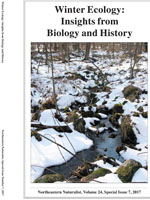I examined winter quiescence (dormancy), growth rate, and competition in the scleractinian coral Astrangia poculata (Northern Star-coral) at an intertidal and a subtidal site in Rhode Island. I observed the onset, duration, and cessation of quiescence from November 2013 to May 2014 and noted when coral tentacles no longer exhibited tactile responses, which I used as a proxy for quiescence. Results demonstrated that intertidal corals entered quiescence in December 2013, when air/water temperatures ranged from 0.71 °C to 5.7 °C, whereas subtidal populations entered quiescence in January when water temperatures ranged from 3.4 °C to 4.3 °C. Corals exited quiescence at similar temperatures (6.0–8.5 °C), again doing so earlier in the intertidal than subtidal populations (April and May 2014, respectively). Corals at both sites grew (added polyps) over the course of the study, but during quiescence, growth ceased in subtidal corals, and intertidal corals lost peripheral polyps. Competitive interactions between Northern Star-coral and the tunicate Didemnum vexillum (Carpet Tunicate) decreased during quiescence with a corresponding increase in “halo” width around each coral. I observed no change in halo-width between coral and the sponge Cliona celata (Red Boring Sponge). All corals examined exhibited winter quiescence, grew during the course of the study, and were released from competition with Carpet Sea-squirt Tunicate; no change in competition with Red Boring Sponge was observed.
How to translate text using browser tools
1 March 2017
Winter Quiescence, Growth Rate, and the Release from Competition in the Temperate Scleractinian Coral Astrangia poculata (Ellis & Solander 1786)
Sean Grace
ACCESS THE FULL ARTICLE

Northeastern Naturalist
Vol. 24 • No. sp7
March 2017
Vol. 24 • No. sp7
March 2017




